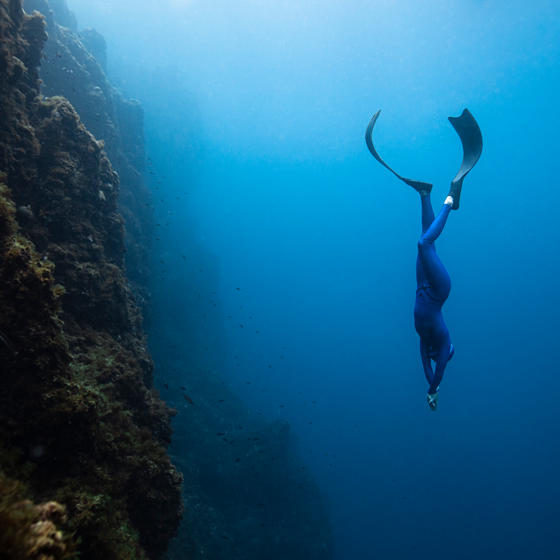In December, adventurer Wendy Searle will attempt to become the fastest-ever woman to ski solo from the Antarctic coast to the South Pole. We sit down with her to talk training, conquering mental blocks and packing light
16 November, 2022
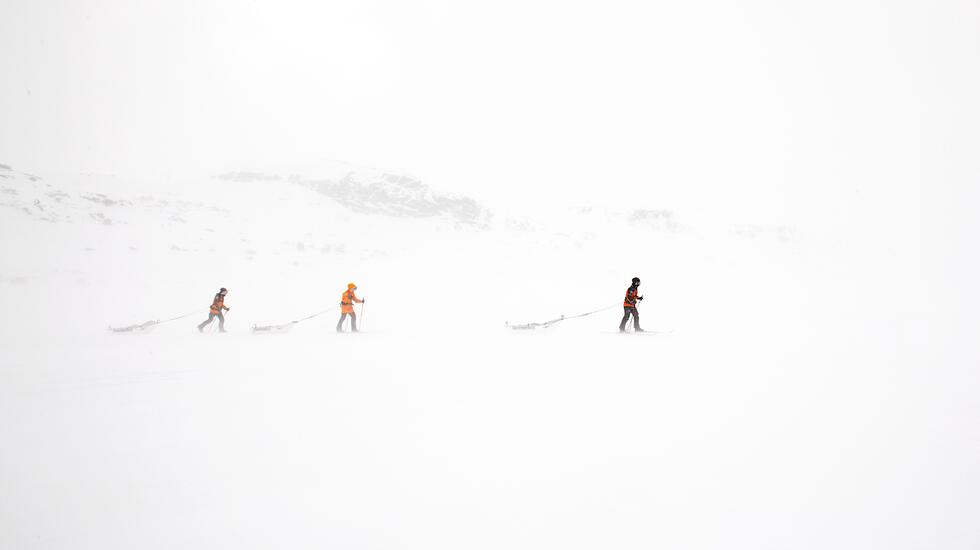
Antarctica
– the world’s southernmost continent and largest
desert – is among one of the harshest environments on Earth. Few
other destinations are as breathtakingly beautiful – nor push the
boundaries of human endurance further. This December, explorer
Wendy Searle will attempt to become the fastest-ever woman to ski
solo from the Antarctic coast to the South Pole – considered
one of the greatest feats for thrill-seeking adventurers.
Searle, who is the polar guide and expedition lead of pioneering
British group Shackleton – which offers transformative treks in some
of the world’s most extreme settings – previously conquered the
route back in 2020. But this time things are different. In order to
become the new record-holder, she will need to cover the 1,150km
distance in just 38 days and 23 hours – shaving five days off her
previous finish.
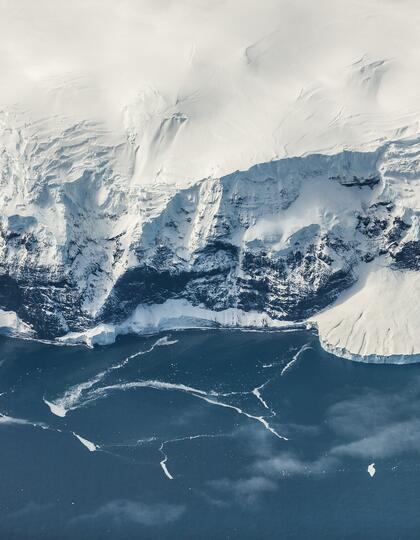
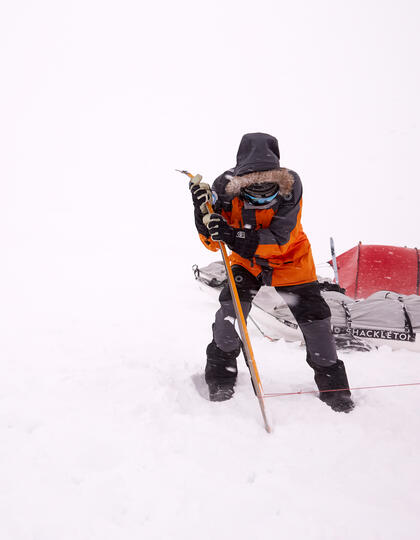
An Antarctic snapshot, left, and Searle in the
snow.
During the journey, Searle, who’ll monitor her progress through
satellite devices, will need to successfully smash a set distance
each day. That, however, is the easy part. As she submerges into
sub-zero temperatures, staying fuelled and controlling her body
heat will be the biggest challenges she faces. In her pulk (sled)
will be just one set of thermals, salopettes, a spare pair of socks
and a down jacket – a shockingly small amount for a five-week trip.
With the countdown on, we caught up with her to uncover what it’s
like to prepare for high altitudes and punishing winds, and where
she finds the mental and physical strength to persevere in darker
hours.
I come from an average background. I’ve never considered myself
gifted at sport (minus the time I made it onto the B team for
netball – on one occasion). But the foundations were built during
my childhood, when my family and I went on frequent walking
holidays – something I didn’t see as the privilege it was at the
time. In my adult life, I developed an appreciation for outdoor
pursuits – starting with marathons and quickly turning to fell
running. That’s when I met a brilliant team who were planning to
cross the Antarctic. When I became their expedition manager, I
became completely obsessed with polar history. After years of
planning, I was able to adventure to the Antarctic myself.
I had one disastrous trip on the slopes when I was at
university, which I put down to the lack of teaching. In 2018, I
completed a two-week course in polar travel, which covered
everything from skiing to camping on snow. There’s a lot to it; the
conditions offer multilayered danger and if you don’t know what
you’re doing, there’s a serious risk of injury. I fell over every
single day and convinced myself I would never ski again, but it was
too late, I had already committed to the Antarctic journey.
I’m lucky that in the last few years, I’ve been on some pretty
exciting adventures. Stepping out of the plane and into the
Antarctic for the first time is definitely up there – it was a
dream come true. Another notable journey was a team trip across the
Greenland ice sheet in 2018, during which we were momentarily
stranded in a piteraq storm. Piteraq is a Greenlandic word that
roughly translates as “that which will do you harm”, meaning no one
could help us. It taught me a lot and definitely sticks with
me.
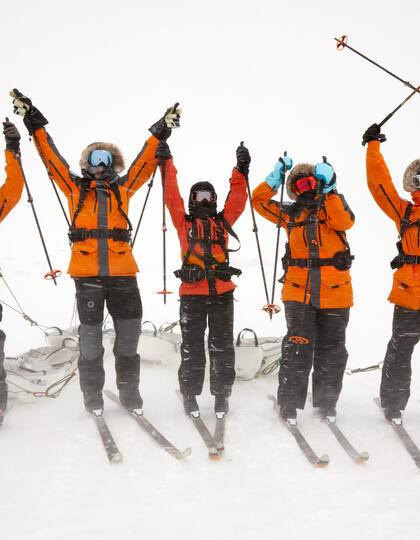
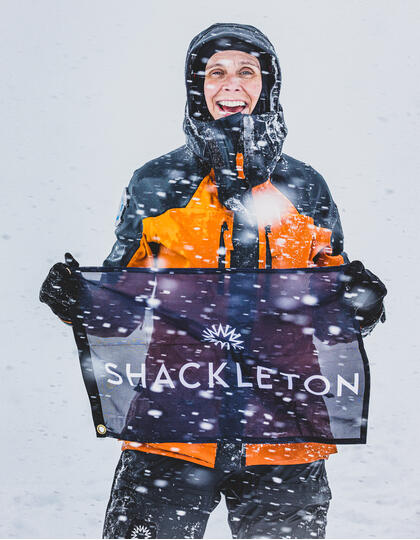
A Shackelton expedition group, left, and a smiling
Searle.
I want to show others that it’s never too late to go for it. I
was in my late-30s when I first ventured down this icy road. It’s
often said that if your passions are not decided by your
late-teens, they are somehow not legitimate – something I’m
determined to prove wrong.
I also want to revisit Antarctica. It’s an extraordinary place.
With no full-time residents nor time zones, it truly exists on its
own terms.
Antarctica is a place of extremes. Its vast landscape and lack
of logistics make human life become minuscule. The isolation is
intense at times – it could be that the closest person at any given
time is in the International Space Station. I often reflect on the
early days of polar explorers and appreciate how far we’ve come
since then: the kit is advanced; I can communicate with my children
at the end of each day. Accomplishing an expedition in a place of
such uncertainty is something I believe to be quite remarkable.
I live in Wales, which is an ideal – and stunning – place to
train. I spend a lot of time in the Brecon Beacons; stomping around
the bogs in the rain is great for endurance. I also train near my
house, in the Wye Valley, where I use weights, do long-distance
running and tyre-hauling sessions to build my overall strength. I’m
currently trying to put on body fat before the journey ahead, which
has been challenging, but the support of the Shackleton team has
helped.
We, as humans, don’t push ourselves to the limits of what the
body is capable of enduring. I try to keep this science in mind
when I’m having a bad day. Telling myself that I can dig deeper
always helps, but often it can be as simple as putting one ski in
front of the other. I’ve accepted that there will be highs and
lows. Fuelling myself with the right snacks and knowing that I am
capable of fixing my own kit helps. Ultimately, no one is going to
fly to Antarctica and rescue me; I have to manage things on my own.
On my last venture, I was pleasantly surprised at how resourceful I
was at the point of crisis – positive learnings that I’ll carry
with me.
Everything I’m taking is essential; there is no room in my pulk
for any luxuries. My most treasured piece of kit is my tent. It’s a
welcome sanctuary after a long day out in the elements. It’s only a
light material and a few poles, but it’s quite literally the
difference between life and death.
In February, I’ll be heading to Norway – the place where I first
started all of this – so it will feel special to return. As for my
next adventure, let me get back to you after I’ve completed this
one.
